|
|
|
Sort Order |
|
|
|
Items / Page
|
|
|
|
|
|
|
| Srl | Item |
| 1 |
ID:
170401
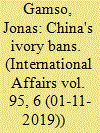

|
|
|
|
|
| Summary/Abstract |
China has been a major market for elephant ivory for centuries. However, the Chinese government recently enacted bans on imports and exports of ivory (2015) and on the domestic ivory trade (2017). These bans appear to have come in response to intensive influence campaigns and public shaming from domestic and foreign activists, who cited declining elephant populations and highlighted China's role. However, this shaming-narrative is at odds with conventional wisdom regarding Chinese policy-making: China typically resists international pressures and its authoritarian government is thought to be largely insulated from domestic efforts by civil society groups. This article reconciles Beijing's ivory policy with these conventional beliefs about policy-making in China. I argue that the Chinese government saw unique benefits to banning the ivory trade, under growing international scrutiny, as doing so enhanced Chinese soft power while having very little impact on its sovereignty or development. Non-government organizations (NGOs) operating both inside and outside of China played a role as well: NGOs in China helped to shift Chinese public opinion towards favouring the bans, while those operating abroad led public relations efforts to publicize Chinese demand for ivory to foreign audiences. Efforts by the latter group of NGOs intensified pressure on the Chinese government to rein in the ivory market, while increasing the soft power benefits that banning ivory would bring to Beijing.
|
|
|
|
|
|
|
|
|
|
|
|
|
|
|
|
| 2 |
ID:
132770
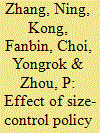

|
|
|
|
|
| Publication |
2014.
|
| Summary/Abstract |
This paper examines the effect of size control policy on the energy and carbon efficiency for Chinese fossil fuel power industry. For this purpose, we propose two non-radial directional distance functions for energy/carbon efficiency analysis of fossil fuel electricity generation. One is named a total-factor directional distance function that incorporates the inefficiency of all input and output factors to measure the unified (operational and environmental) efficiency of fossil fuel power plants, and the other is called an energy-environmental directional distance function that can be used to measure the energy-environmental performance of fossil fuel electric power plants. Several standardized indicators for measuring unified efficiency and energy-environmental performance are derived from the two directional distance functions. An empirical study of 252 fossil fuel power plants in China is conducted by using the proposed approach. Our empirical results show that there exists a significant positive relationship between the plant size and unified efficiency, the five state-owned companies show lower unified efficiency and energy-environmental performance than other companies. It is suggested that Chinese government might need to consider private incentives and deregulation for its state-owned enterprises to improve their performance proactively.
|
|
|
|
|
|
|
|
|
|
|
|
|
|
|
|
| 3 |
ID:
132771
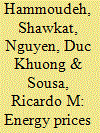

|
|
|
|
|
| Publication |
2014.
|
| Summary/Abstract |
We use a quantile regression framework to investigate the impact of changes in crude oil prices, natural gas prices, coal prices, and electricity prices on the distribution of the CO2 emission allowance prices in the United States. We find that: (i) an increase in the crude oil price generates a substantial drop in the carbon prices when the latter is very high; (ii) changes in the natural gas prices have a negative effect on the carbon prices when they are very low but have a positive effect when they are quite high; (iii) the impact of the changes in the electricity prices on the carbon prices can be positive in the right tail of the distribution; and (iv) the coal prices exert a negative effect on the carbon prices.
|
|
|
|
|
|
|
|
|
|
|
|
|
|
|
|
| 4 |
ID:
128826
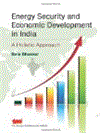

|
|
|
|
|
| Publication |
New Delhi, The Energy and Resources Institute (TERI), 2013.
|
| Description |
xviii, 353p.Hbk
|
| Standard Number |
9788179934609
|
|
|
|
|
|
|
|
|
|
|
|
Copies: C:1/I:0,R:0,Q:0
Circulation
| Accession# | Call# | Current Location | Status | Policy | Location |
| 057660 | 333.790954/BHA 057660 | Main | On Shelf | General | |
|
|
|
|
| 5 |
ID:
144487
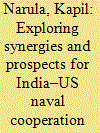

|
|
|
|
|
| Summary/Abstract |
India and the US are strengthening their strategic and military partnership under the 10-year defense framework agreement. This paper proposes that there exists a strong case to extend this cooperation into the realm of energy and environment, and explores the synergies and prospects between the navies of the two countries. The paper argues that navies have a prime role in contributing to energy security and environmental protection, and this function will gain increasing relevance in the forthcoming decades. A comparative assessment of energy use, and the energy and environment roadmaps, of the US navy and the Indian navy are presented to highlight the similar challenges and actions being undertaken to address the common concerns. The paper also proposes specific elements and the scope of naval cooperation in the relevant domains before concluding that such a programme will be mutually beneficial for the two navies.
|
|
|
|
|
|
|
|
|
|
|
|
|
|
|
|
| 6 |
ID:
170393


|
|
|
|
|
| Summary/Abstract |
It is more than 20 years since Marysia Zalewski and feminist scholars posed ‘the man question’ in International Relations, repositioning the gaze from female subjectivities to a problematization of the subjecthood of man. The field of masculinity studies has developed this initial question to a deep interrogation of the relationship between maleness and violence. Yet public and policy discourse often reduce the complexity of masculinities within extremism to issues of crisis and toxicity. Governments have prioritized the prevention of extremism, particularly violent Islamism, and in so doing have produced as ‘risk’ particular racialized and marginalized men. This article asks, what are the effects of the toxic masculinity discourse in understanding the British radical right? It argues that current understandings of extremism neglect the central aim of Zalewski's ‘man’ question to destabilize the field and deconstruct patriarchy. They instead position Islamophobia—which is institutionalized in state discourse—as the responsibility of particular ‘extreme’ and ‘toxic’ groups. In particular, the article outlines two ways in which ‘toxic masculinity’ is an inadequate concept to describe activism in the anti-Islam(ist) movement the English Defence League (EDL). First, the term ‘toxic masculinity’ occludes the continuities of EDL masculinities with wider patriarchal norms; second, it neglects the role of women as significant actors in the movement. Using an ethnographic and empathetic approach to this case-study, the article explores how Zalewski's theoretical position offers a route to analysis of the ways in which masculinities and patriarchy entwine in producing power and violence; and to a discussion of masculinities that need not equate manhood with threat.
|
|
|
|
|
|
|
|
|
|
|
|
|
|
|
|
| 7 |
ID:
133247
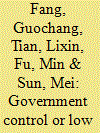

|
|
|
|
|
| Publication |
2014.
|
| Summary/Abstract |
This paper explores a novel selective-constrained energy-saving and emission-reduction (ESER) dynamic evolution system, analyzing the impact of cost of conserved energy (CCE), government control, low carbon lifestyle and investment in new technology of ESER on energy intensity and economic growth. Based on artificial neural network, the quantitative coefficients of the actual system are identified. Taking the real situation in China for instance, an empirical study is undertaken by adjusting the parameters of the actual system. The dynamic evolution behavior of energy intensity and economic growth in reality are observed, with the results in perfect agreement with actual situation. The research shows that the introduction of CCE into ESER system will have certain restrictive effect on energy intensity in the earlier period. However, with the further development of the actual system, carbon emissions could be better controlled and energy intensity would decline. In the long run, the impacts of CCE on economic growth are positive. Government control and low carbon lifestyle play a decisive role in controlling ESER system and declining energy intensity. But the influence of government control on economic growth should be considered at the same time and the controlling effect of low carbon lifestyle on energy intensity should be strengthened gradually, while the investment in new technology of ESER can be neglected. Two different cases of ESER are proposed after a comprehensive analysis. The relations between variables and constraint conditions in the ESER system are harmonized remarkably. A better solution to carry out ESER is put forward at last, with numerical simulations being carried out to demonstrate the results.
|
|
|
|
|
|
|
|
|
|
|
|
|
|
|
|
| 8 |
ID:
162307
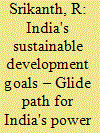

|
|
|
|
|
| Summary/Abstract |
India has adopted the 2030 Agenda during the United Nations Summit held in September 2015. Energy is intimately connected with 74% of the 169 targets related to the 17 Sustainable Development Goals (SDGs) to be achieved by 2030. Subsequently, India has also submitted its Nationally Determined Contributions (NDCs) for the period 2021–2030 to the United Nations Framework Convention on Climate Change (UNFCCC). While the Government of India (GOI) has ambitious plans for enhancing the installed capacity of RE sources, 75% of its electricity is currently generated by coal-fired power plants. As India's electricity requirements grow to meet the aspirations of 1.3 Bi people, it needs a policy framework that integrates all low-carbon energy technologies with coal in such a manner that the reliability, security, and affordability of electric supply are balanced with sustainable development. India also needs to develop innovative strategies to clean up the country's coal sector while enhancing the integration of renewable energy into the National Power Grid. In this context, certain recommendations are proposed in this article for timely implementation by GOI to facilitate the achievement of India's targets with respect to SDG 7 and the NDCs in an efficient and effective manner.
|
|
|
|
|
|
|
|
|
|
|
|
|
|
|
|
| 9 |
ID:
133265
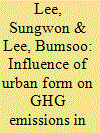

|
|
|
|
|
| Publication |
2014.
|
| Summary/Abstract |
To better understand the role of sustainable urban development in greenhouse gas (GHG) mitigation, this study examines the paths by which urban form influences an individual household×s carbon dioxide emissions in the 125 largest urbanized areas in the U.S. Our multilevel SEM analyses show that doubling population-weighted density is associated with a reduction in CO2 emissions from household travel and residential energy consumption by 48% and 35%, respectively. Centralized population and polycentric structures have only a moderate impact in our analyses. Given that household travel and residential energy use account for 42% of total U.S. carbon dioxide emissions, these findings highlight the importance of smart growth policies to build more compact and transit friendly cities as a crucial part of any strategic efforts to mitigate GHG emissions and to stabilize climate.
|
|
|
|
|
|
|
|
|
|
|
|
|
|
|
|
| 10 |
ID:
133244


|
|
|
|
|
| Publication |
2014.
|
| Summary/Abstract |
Environmental degradation has become a central issue of discussion among the economists and environmentalists. In view of Malaysia's position as one of the main contributors to CO2 emissions in Asia and its status as a fast growing economy, it is vital, therefore, to conduct a study to identify the relationship between economic growth and CO2 emissions for Malaysia. This study attempts to examine empirically the environmental Kuznets curve hypothesis for Malaysia in the presence of foreign direct investment and trade openness both in the short- and long-run for the period 1970 to 2008.The bounds testing approach and Granger causality methodology are applied to test the interrelationships of the variables. The results of our study indicate that the inverted-U shaped relationship does exist between economic growth and CO2 emission in both the short- and long-run for Malaysia after controlling for two additional explanatory variables, namely FDI and trade. Importantly, the results of the study also provide some crucial policy recommendations to the policy makers.
|
|
|
|
|
|
|
|
|
|
|
|
|
|
|
|
| 11 |
ID:
133261


|
|
|
|
|
| Publication |
2014.
|
| Summary/Abstract |
Grid-connected solar photovoltaic (PV) power is currently one of the fastest growing power-generation technologies in the world. While PV technologies provide the environmental benefit of zero emissions during use, the use of heavy metals in thin-film PV cells raises important health and environmental concerns regarding the end-of-life disposal of PV panels. To date, there is no published quantitative assessment of the potential human health risk due to cadmium leaching from cadmium telluride (CdTe) PV panels disposed in a landfill. Thus, we used a screening-level risk assessment tool to estimate possible human health risk associated with disposal of CdTe panels into landfills. In addition, we conducted a literature review of potential cadmium release from the recycling process in order to contrast the potential health risks from PV panel disposal in landfills to those from PV panel recycling. Based on the results of our literature review, a meaningful risk comparison cannot be performed at this time. Based on the human health risk estimates generated for PV panel disposal, our assessment indicated that landfill disposal of CdTe panels does not pose a human health hazard at current production volumes, although our results pointed to the importance of CdTe PV panel end-of-life management.
|
|
|
|
|
|
|
|
|
|
|
|
|
|
|
|
| 12 |
ID:
133243
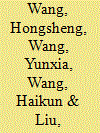

|
|
|
|
|
| Publication |
2014.
|
| Summary/Abstract |
Knowledge of the factors driving greenhouse gas (GHG) emissions from cities is crucial to mitigating China's anthropogenic emissions. In this paper, the main drivers increasing GHG emissions from the Chinese city of Suzhou between 2005 and 2010 were identified and quantitatively analyzed using the Kaya identity and the log-mean Divisia index method. We found that economy and population were the major drivers of GHG emissions in Suzhou, having contributed 162.20% and 109.04%, respectively, to the increase in emissions. A decline in carbon intensity, which was caused by the declining energy intensity and an adjustment to the mixture of power and industrial structures, was the major determinant and accounted for a reduction of 171.24% in GHG emissions. Slowing and maintaining healthy growth rates of economy and population could be the primary and most effective means if Suzhou tries to curb the total emissions over the short term. It may be more realistic for Suzhou to control emissions by optimizing the economic structure for low-carbon industrial development because of the city's relative high energy requirements and low potential to mitigate GHGs by adjusting the energy mixture.
|
|
|
|
|
|
|
|
|
|
|
|
|
|
|
|
| 13 |
ID:
191566
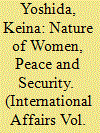

|
|
|
|
|
| Summary/Abstract |
On 12 November 2019, the Special Jurisdiction for Peace (JEP), handed down a landmark decision in the case of ‘Katsa Su’ concerning the Awa indigenous group in Colombia. The Colombian conflict has particularly affected indigenous groups, such as the Awa people, and has also affected the territory in which they live. In this article, we explore the decision of the JEP, within a broader analysis of the Colombian peace agreement and consider how it might help us to think about the place of the environment in the Women, Peace and Security agenda and in international law. We call for a gendered and intersectional approach to environmental peacebuilding which is attentive to the importance of gender and different groups. Further, we highlight how the Colombian example shows how concepts such as relief, recovery and reparations are often confined in international law to women's recovery and redress with respect to sexual violence and yet, this conceptualization should be much broader. The Katsa Su case provides an example of the fact that reparations and redress must address other forms of violence, spiritual and ecological, which women also suffer in times of conflict.
|
|
|
|
|
|
|
|
|
|
|
|
|
|
|
|
| 14 |
ID:
132769
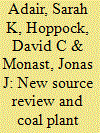

|
|
|
|
|
| Publication |
2014.
|
| Summary/Abstract |
Forthcoming carbon dioxide (CO2) regulations for existing power plants in the United States have heightened interest in thermal efficiency gains for coal-fired power plants. Plant modifications to improve thermal efficiency can trigger New Source Review (NSR), a Clean Air Act requirement to adopt of state-of-the-art pollution controls. This article explores whether existing coal plants would likely face additional pollution control requirements if they undertake modifications that trigger NSR. Despite emissions controls that are or will be installed under the Mercury and Air Toxics Standards (MATS) and Clean Air Interstate Rule (CAIR) or its replacement, 80% of coal units (76% of capacity) that are expected to remain in operation are not projected to meet the minimum NSR requirements for at least one pollutant: nitrogen oxides or sulfur dioxide. This is an important consideration for the U.S. Environmental Protection Agency and state policymakers as they determine the extent to which CO2 regulation will rely on unit-by-unit thermal efficiency gains versus potential flexible compliance strategies such as averaging, trading, energy efficiency, and renewable energy. NSR would likely delay and add cost to thermal efficiency projects at a majority of coal units, including projects undertaken to comply with forthcoming CO2 regulation.
|
|
|
|
|
|
|
|
|
|
|
|
|
|
|
|
| 15 |
ID:
191565
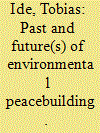

|
|
|
|
|
| Summary/Abstract |
Environmental peacebuilding is a rapidly growing field of research and practice at the intersection of environment, conflict, peace and security. Focusing on these linkages is crucial in a time when the environment is a core issue of international politics and the number of armed conflicts remains high. This article introduces a special issue with a particular emphasis on environmental opportunities for building and sustaining peace. We first detail the definitions, theoretical assumptions and intellectual background of environmental peacebuilding. The article then provides context for the special issue by briefly reviewing core findings and debates of the first two generations of environmental peacebuilding research. Finally, we identify knowledge gaps that should be addressed in the next generation of research, and to which the articles in this special issue contribute: bottom-up approaches, gender, conflict-sensitive programming, use of big data and frontier technology, and monitoring and evaluation.
|
|
|
|
|
|
|
|
|
|
|
|
|
|
|
|
| 16 |
ID:
133251
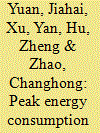

|
|
|
|
|
| Publication |
2014.
|
| Summary/Abstract |
China is in the processes of rapid industrialization and urbanization. Based on the Kaya identity, this paper proposes an analytical framework for various energy scenarios that explicitly simulates China×s economic development, with a prospective consideration on the impacts of urbanization and income distribution. With the framework, China×s 2050 energy consumption and associated CO2 reduction scenarios are constructed. Main findings are: (1) energy consumption will peak at 5200-5400 million tons coal equivalent (Mtce) in 2035-2040; (2) CO2 emissions will peak at 9200-9400 million tons (Mt) in 2030-2035, whilst it can be potentially reduced by 200-300 Mt; (3) China×s per capita energy consumption and per capita CO2 emission are projected to peak at 4 tce and 6.8 t respectively in 2020-2030, soon after China steps into the high income group.
|
|
|
|
|
|
|
|
|
|
|
|
|
|
|
|
| 17 |
ID:
168425


|
|
|
|
|
| Summary/Abstract |
In this article, we examine China's promotion of the renminbi (RMB) in international oil trade and explore its implications for the international currency system in the short and the long term. The article traces the rise of the RMB in international oil trade in recent years and provides an analysis of its impact on the internationalization of the Chinese currency. We argue that despite the increasing use of the yuan in oil trade in recent years, in the short term it is highly unlikely that a petro-RMB system will emerge to rival the petrodollar system. Unlike the petrodollar, which combines the qualities of a master currency, a top currency and a negotiated currency, China lacks the economic leadership and the political and geopolitical leverages to make the RMB a major petrocurrency. Although the emergence of the RMB-denominated Shanghai oil futures is an important development, the absence of highly developed financial markets and a strong legal system in China hinders its potential. In the long run, the RMB may take on a more prominent role in the international oil trade as China's weight as an oil importer rises. More importantly, the overuse of financial sanctions by the US government has begun to undermine the role of the dollar within and beyond the oil trade. In addition, the rise of alternative energy sources will diminish the centrality of oil in the world economy, thus reducing the significance of petrocurrencies—whether the dollar or the RMB—in shaping the international currency system.
|
|
|
|
|
|
|
|
|
|
|
|
|
|
|
|
| 18 |
ID:
133293


|
|
|
|
|
| Publication |
2014.
|
| Summary/Abstract |
Road transport in India plays a vital role in our growing economy. Given an aggressive vehicle sales outlook through 2030, in order to maintain a balance between the energy demand, growing on-road emissions, and overall air quality in the cities, there is a need to implement and enforce Bharat-5 standards (equivalent of Euro-V) nationwide by 2015. Any delay in its implementation or even staggered implementation of the standards will result in a delayed response for improving air quality in the Indian cities.
|
|
|
|
|
|
|
|
|
|
|
|
|
|
|
|
| 19 |
ID:
165041


|
|
|
|
|
| Summary/Abstract |
State and non-state actors across many protracted conflicts and prolonged occupations in the Middle East and North Africa have systematically targeted civilian infrastructures. We use the cases of the West Bank and Gaza, characterized by more than five decades of occupation and periods of intermittent violent conflict, to analyse how the targeting of water, energy, and agricultural infrastructures has created humanitarian crises and undermined civilian livelihoods. Our analysis draws upon an original database tracking the targeting of environmental and civilian infrastructures and on interviews with humanitarian organizations, government officials and civil society actors. The analysis shows how the targeting of infrastructure has differed in the West Bank and the Gaza Strip. In the West Bank, damage to essential infrastructure and restrictions on infrastructure development are forms of slow violence that accumulate over time, carried out by both state authorities and settlers. In the Gaza Strip, recurrent violent conflict between Israel and Hamas has produced extensive destruction across all types of infrastructure, while the internationally-sanctioned blockade has hindered effective reconstruction. In both cases agriculture is the most frequently targeted sector, undermining livelihoods and connections to land, while damage to water and energy systems has limited economic activity and rendered civilian life increasingly precarious.
|
|
|
|
|
|
|
|
|
|
|
|
|
|
|
|
| 20 |
ID:
133290


|
|
|
|
|
| Publication |
2014.
|
| Summary/Abstract |
Using energy data over the period 1981-2011 we find that US biofuels subsidies and production have provided a perverse incentive for US fossil fuel producers to increase their rate of extraction that has generated a weak green paradox. Further, in the short-run if the reduction in the CO2 emissions from a one-to-one substitution between biofuels and fossil fuels is less than 26 percent, or less than 57 percent if long run effect is taken into account, then US biofuels production is likely to have resulted in a strong green paradox. These results indicate that subsidies for first generation biofuels, which yield a low level of per unit CO2 emission reduction compared to fossil fuels, might have contributed to additional net CO2 emissions over the study period.
|
|
|
|
|
|
|
|
|
|
|
|
|
|
|
|
|
|
|
|
|